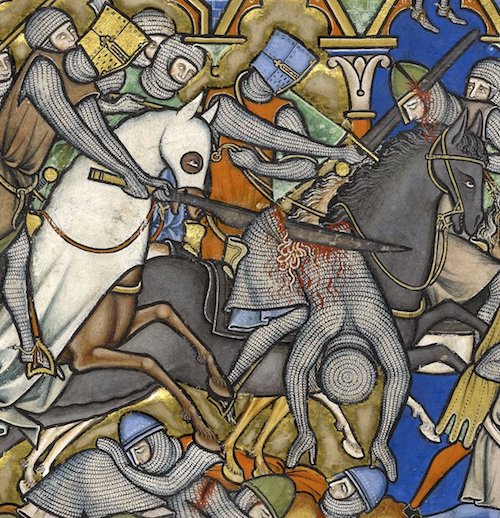We run our website the way we wished the whole internet worked: we provide high quality original content with no ads. We are funded solely by your direct support. Please consider supporting this project.

The Violent “Church Triumphant”
In light of how central enemy-loving non-violence is to Jesus’ teaching and to his cross-centered revelation of God, we have to wonder why the church has refused to listen to its head and instead condoned violence, as pointed out in the previous post? Christian theologians have used OT’s violent portraits of God, at least since fourth century to promote the use of violence. For example, how could Luther have failed to wrestle with the violent portraits of the Old Testament when he claimed to “see nothing in Scripture except Christ crucified”?
For the first three centuries of church history, theologians such as Origen found non-literal ways of interpreting the OT’s violent divine portraits so that they could not be used to promote violence. Christians during this period took seriously Jesus’ call to refrain from violence and to love and serve enemies. However beginning in the early fourth century, the church began to undergo a massive transformation.
It began when a Roman emperor named Constantine allegedly had a vision just before a major battle he was going to fight. This vision convinced him that he and his army would defeat their foes if he fought under the banner of Christ. This was the first (but unfortunately hardly the last) time the name of Jesus Christ was associated with violence. Constantine won the battle, and since pagans have always assumed that military victories reveal which army has the stronger god, Constantine decided to pledge his allegiance to Christ. However, his version of Christ was a triumphant pagan warrior deity rather than as the self-sacrificial loving Savior.
Constantine legalized Christianity in 313 A.D. and he showered the Church with wealth and political power. In the span of less than a century, the Church went from being a despised and persecuted minority within the Roman Empire to the official religion of the Roman Empire, making it illegal for everyone except Jews not to be a Christian. And since the religion of Rome had always played an important role in the running of the State, the Church began to play this role.
However, it’s impossible to play any role in running the Roman Empire (or any other empire for that matter) if you’re not willing to use the sword to preserve law and order and to protect the State from threatening foes. So, not surprisingly, in the fourth and fifth centuries we find Christian theologians like St. Augustine going to extreme lengths to try to justify the use of violence, despite the NT’s clear teachings to the contrary.
Whereas the persecuted Church of the first three centuries believed it was called to refrain from violence and serve the world by carrying the cross, the politically-empowered Church of the fourth and fifth centuries began to believe it was called to conquer the world for Christ, wielding the sword when necessary. The persecuted Church became the persecuting “Church Triumphant,” since it now had the political authority to persecute heretics and unbelievers. The Empire of Rome was retitled “the holy Roman Empire,” and Christ was believed to be its triumphant Emperor. “Christendom” was born, and while this religion has (thankfully) been dying for the last several hundred years, it has, for all intents and purposes, been the face of Christianity for the last fifteen hundred years.
As Christendom was coming into being, and Christians acclimated to the use of violence, the OT’s violent depictions of God became much less problematic. Indeed, it became advantageous at this time to interpret these portraits literally. Christendom’s leaders could appeal to them when they needed to justify their use of violence and when they needed to motivate Christians to engage in violence on behalf of their “Christian” Empire. Tragically, these violent portraits have been serving this function ever since.
Image: Fatality, ‘Maciejowski Bible’, Paris ca. 1240 (NY, Morgan Library & Museum, MS M.638, fol. 10v)
Category: General
Tags: Augustine, Constantine, Cruciform Theology, Jesus, Violence
Topics: Enemy-Loving Non-Violence, The Church
Related Reading

Don’t Be a Functional Atheist at Christmas
All of us raised in Western culture have been strongly conditioned by what is called a secular worldview. The word secular comes from the Latin saeculum, meaning “the present world.” A secular worldview, therefore, is one that focuses on the present physical world and ignores or rejects the spiritual realm. To the extent that one…

Join the Revolution!
We are living at a very important, and very exciting, juncture of history. The old religion of Christendom that has been identified with “Christianity” the last 1600 years is dying, and out of its ruins is arising a new tribe of kingdom revolutionaries. All around the globe people are getting the revelation that the kingdom…

Violent Thinking
When most people think of violence, they think of physical violence. But the truth is that our actions are only violent because our hearts and minds are violent first. For this reason, Jesus emphasizes purging violence from our minds as much as from our physical behavior. In Matt 5:21-26, he reminds us of the OT…

The Trinity and the Crucified God
God has always been willing to stoop to accommodate the fallen state of his covenant people in order to remain in a transforming relationship with them and in order to continue to further his sovereign purposes through them. This is revealed in the life and death of Jesus. Out of love for humankind, Jesus emptied…

Does the Old Testament Justify “Just War”?
Since the time of Augustine, Christians have consistently appealed to the violent strand of the Old Testament to justify waging wars when they believed their cause was “just.” (This is Augustine’s famous “just war” theory.) Two things may be said about this. First, the appeal to the OT to justify Christians fighting in “just” wars…

Forgiving the Unforgivable
Osheta Moore wrote a courageous and challenging post last week entitled Washing the Feet of the Steubenville Rapists. It’s not an easy read, and if you’re vulnerable to triggers in this area, you might want to exercise caution. But Osheta offers a glimpse of redemption in the darkest of places. Can we move towards forgiveness…
